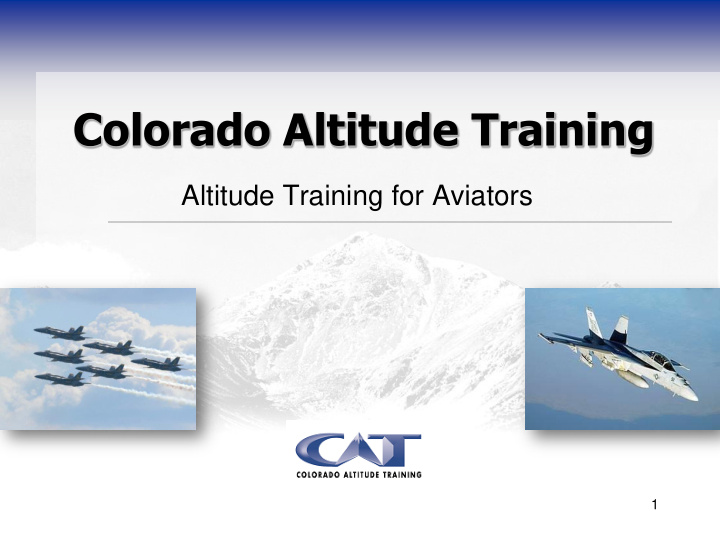



Colorado Altitude Training Altitude Training for Aviators 1
Problem Statement Hypoxia training in a hypobaric environment can be hazardous • Annual hypoxia training required for all pilots and aircrew • Every year 40-60 trainees are subject to barotrauma injuries in hypobaric altitude chambers • Hypoxia training is considered to be hazardous duty 2
Organizations with the Problem 3
Baseline Technology Low Pressure Chamber - Expensive to Purchase - Expensive to Maintain - Barotraumas & Decompression Sickness - Limited Size & Access - Limited Protocols 4
Customer Needs Ideal Hypoxia Training Chamber • No risk of barotrauma to instructors and trainees • Readily configured for multiple training scenarios • Easily deployed and redeployed
CAT Aviation Systems 6 2012 - Navy Aviation - Pensacola
Technology – The System Air O2 7
Performance Specifications Feature Advantage Benefit Normobaric pressure No risk of DCS or Safety of trainees and barotrauma injuries trainers Altitude simulation to Create hypoxic training Specific training for 30,000 feet scenarios for all aircraft specific aircraft Flight Simulator Operational hypoxia High fidelity training Compatible training scenarios Hypoxic Chamber Realistic to cockpit Realistic loss oxygen environment at altitude training scenarios
Advantages • Less expensive – Immediately cost effective – 1/33 the cost of “altitude chambers” – Less expensive to buy new than to continue with old – No cost for injuries – Lower personnel requirement • Better fidelity of training 9
Advantages • Sizing – Make it any size – Fit any room • Works in the real world training environment – Immediate entry or exit – No hazardous duty pay – Efficient training – rapid turnover – Flight simulator compatible 10
Current Status • The first prototype (TRL 5) is already installed at the Aviation Survival Training Center in Miramar • CAT already incorporated Naval Survival Training Institute (NTSI) recommendations and additional testing to TRL 6 • A second prototype (TRL 7) is now installed at NSTI in Pensacola. 11
Transition to the Fleet TRL Milestone Date 6 Stabilization of 30,000 feet in specified size March, 2012 enclosure 7 Suitably maintaining oxygen and carbon dioxide April, 2013 during repeated Navy training sessions 9 Successfully complete validation of installed June, 2013 chamber
Types of Partners Sought • DoD agencies, other government agencies and commercial entities that perform: – Hypoxia altitude training – Altitude training – Endurance conditioning – Fire prevention or suppression
CAT’s Anticipated Role • Manufacture of chamber • Installation • Validation support • Upgrades • Customer support
About Colorado Altitude Training • CAT is a world leader in oxygen control – Altitude training systems for NHL, NBA and US Olympic Training Center – Hypoxic/Altitude Research at Mayo Clinic, US Army Research Institute, and universities world wide – Fire prevention system for the “Stars Spangled Banner” at Smithsonian Institutions’ National Museum of American History
Recommend
More recommend